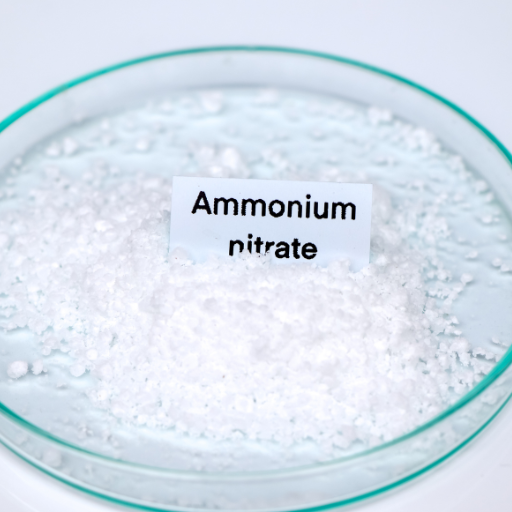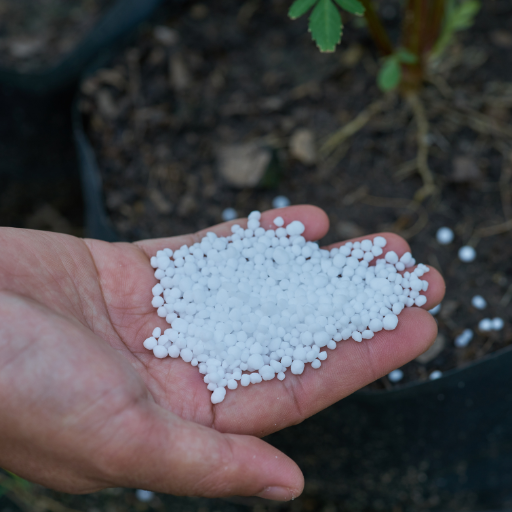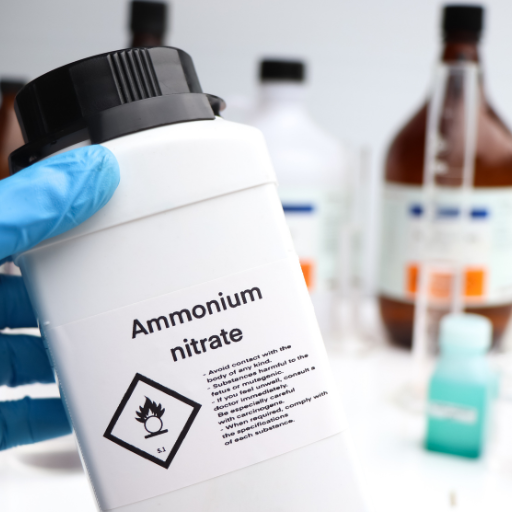The efficiency of ammonium nitrate as a plant growth promoter has lead to it being widely acknowledged and used in agriculture. The compound, famous for its large amount of nitrogen content, is essential for ensuring that plants are adequately nourished. In this blog we will discuss why ammonium nitrate is the most popular fertilizers and look at what makes it so effective and how it enhances plant health. If you are an experienced farmer or just a gardening lover, knowing the benefits of using ammonium nitrate will help you come up with a well-informed decision regarding your fertilization strategies. So let’s discover together chemicals which can make a plant grow up rapidly – the major one among those is ammonium nitrate.
What is Ammonium Nitrate?

Ammonium nitrate is comprised of ammonium ions and nitrate ions, thus having the formula NH₄NO₃. It is highly soluble crystalline material frequently used in fertilisers due to its high nitrogen content. Nitrogen is an essential plant nutrient that promotes lush foliage, strong growth and general good plant health. This compound is highly valued because it supplies nitrogen in a very available form to plants, making it the best choice for boosting agricultural yields.
Understanding the Chemical Compound
The chemical compound ammonium nitrate results from combining ammonia (NH₃) with nitric acid (HNO₃). It has high solubility in water, which helps it be assimilated by plant roots when dissolved in soil moisture. Through its solubility, it ensures that plants obtain nitrogen that includes amino acids, proteins and chlorophyll needed for vigorous development and growth. Moreover, the nitrate ion (NO₃⁻) can be taken up by plants easily; hence ammonium nitrate becomes one of the most effective fertilizers for diverse crops.
Production of Ammonium Nitrate
Therefore on this basis ammonia gas (NH₃) reacts with nitric acid (HNO₃), resulting in a very soluble crystalline substance known as ammonium nitrate. The industrial procedure initiates with vaporization of ammonia gas followed by introduction into a reactor containing nitric acid. In order to regulate temperature and avoid decomposition of product requires; they generate excess heat as part of exothermic reaction mechanics, therefore efficient cooling systems are necessary.
- Ammonia Feedstock: Typically 99.5% pure to ensure quality and efficiency.
- Nitric Acid Concentration: Generally ranges from 50% to 68%, with temperatures controlled between 60°C to 80°C during the reaction to optimize yield and minimize by-products.
- Reaction Temperature: Maintained around 150°C in the neutralization reactor.
- pH Levels: Monitored and kept slightly acidic (around pH 4-5) to facilitate complete neutralization.
- Cooling Systems: Essential to dissipate the heat generated and solidify the ammonium nitrate solution into prilled or granulated form, depending on the end use.
Once the neutralization is complete, the solution is concentrated through evaporation and then solidified, either as prills or granules, by spraying it through a prilling tower or granulator. The end product is cooled, screened for uniformity, and coated with anti-caking agents to ensure easy handling and storage.
Solid Ammonium Nitrate Versus Solutions
When it comes to applications and handling characteristics, solid ammonium nitrate differs so much from ammonium nitrate solutions. In agriculture, solid ammonium nitrate comes in the form of prilled or granulated and is largely used as a high-nitrogen fertilizer while in mining industry, explosives are made out of it since it can be moved around easily and stored. On the other hand, ammonium nitrate solutions which basically result from dissolving the solid form into water are useful for industrial activities such as manufacturing of urea ammonium nitrate (UAN) fertilizers where liquid handling systems provide an avenue for accurate application. Choice between solids and solutions depends on specific requirements of use case taking into account factors like method of application, transportation logistics and storage conditions.
How Does Ammonium Nitrate Benefit Plant Growth?

The main benefit of Ammonium nitrate for plant growth is that it provides plants with nitrogen which they can readily utilize as an essential plant nutrient. Nitrogen is indispensable in chlorophyll, a substance used by plants to convert sunlight into energy in the photosynthesis process. Furthermore, amino acids, the building blocks of proteins and nucleic acids which play a major part in the development and growth of plants are created from this element. Robust growth, increased yield and improved overall health of plants result from ammonium nitrate’s high nitrogen content that ensures adequate supplies of this nutrient. Its quick solubility in water allows roots to take it up more efficiently than other sources, hence faster absorption.
A Major Nitrogen Source
Ammonium nitrate is considered to be a major source of nitrogen because it has both nitrates and ammonium ions for easy and quick absorption of this vital nutrient by plants. Nitrogen plays an important role during photosynthesis as well as protein synthesis which are necessary for normal plant development. Water soluble allowing its rapid uptake through root systems while ammonium is also slowly released so that nutrients are continuously available. Ammonium nitrate supplies fast and sustained release of nitrogen to encourage vegetative growth; boost crop yield, overall vigor.
Increased Nutrient Uptake
Ammonium nitrate largely enhances nutrient uptake by combining both forms of nitrogen as nitrates and ammonia salts such as ammonium respectively. The immediate availability after its uptake by roots can be attributed to the rapidity at which nitrates can be absorbed by plants while ammonia salts provide long-term supply through constant release rates of nitrogenous compounds. It ensures that there is always a balance between sufficient but not excessive nitrogen supply for proper growth and development thus making it inevitable among key technical parameters justifying top sources like: solubility rate; its nitrogen content viz 34%. In particular because at 20°C it has a solubility rate of 1920g/L and it will rapidly dissolve in water and be immediately available to plants. Additionally, its nitrogen content is typically around 34%, making it a rich source of nitrogen for the fast-growing crop’s high requirements. This has made ammonium nitrate popular among farmers due to its effectiveness in nutrient delivery.
Comparison with Other Nitrogen Fertilizers
When comparing ammonium nitrate to other nitrogen fertilizers, several key factors must be considered, including nutrient composition, solubility and impact on soil pH. Urea, another example, is one of the widely used synthetic nitrogen-based fertilizers with high concentration of approximately forty-six percent (46%) nitrogen. Nonetheless, urea hydrolysis through ammonia production by soil bacteria followed by conversion into nitrates may delay availability to plants. Moreover; over time urea could lead to soil acidification hence affecting long-term soil health.
Ammonium sulfate is yet another common nitrogen fertilizer containing about 21% N and 24% S. Although it provides some needed sulfur, its level of N remains below that found in ammonium nitrate. Furthermore it does not have enough soluble % gates or latterly plant nutrients compared to those found on AN.
Calcium Ammonium Nitrate (CAN) contains about twenty seven percent (27%) balanced nitrogen and has calcium element which neutralizes acidity in soils. By combining these two properties CAN reduces the risk of loss of alkalinity from soils when compared with other major N fertilizers; this is why it is known as an efficient alternative for direct nutrient supply especially during situations that call for immediate response like one offered by AN due to highly soluble nature anticipated for both materials
In short, ammonium nitrate is the best because among urea, ammonium sulfate and calcium ammonium nitrate it has the best combination of rapid nutrient uptake and long lasting availability. This efficiency improves plant growth making it a preferred option in modern agriculture.
How to Use Ammonium Nitrate Effectively in Agriculture?

To effectively use ammonium nitrate in agriculture, you must first conduct a soil test to evaluate the insufficiency of nutrients and accordingly adjust application rates. Apply ammonium nitrate at the appropriate rate typically ranging between 50-100 pounds per acre depending on what the crop requires. It is most effective when applied during growing seasons as this is when crops benefit maximally from available nitrogen. When applying ensure that it’s spread uniformly by broadcasting or banding and always work it into the soil to reduce nitrogen loss due to volatilization. Moreover, timing is also important; applying ammonium nitrate near active growth periods will have higher uptake and efficiency compared to other times.
Throughout the growing season, practices may need to be adjusted to ensure optimal nutrient availability to plants based on regular monitoring of crop health and soil conditions.
Methods of application
Broad spreading is one of the commonest ways of getting ammonium nitrate all over your fields. Here, fertilizer is evenly put across a field surface using equipment such as a spreader. It’s valuable for large expanses and its good for crops with extensive root systems. Banding as well is an effective technique where concentrated strips are placed beside seeds or rows of plants for precise delivery of nutrients. This reduces nutrient losses while increasing nitrogen availability for uptake by growing plants.
Sometimes foliar application can be used especially if there are specific crops that require instant supply of nutrients. Dissolving ammonium nitrate in water then spraying directly on crop foliage describes this method. It creates an immediate response in cases where visible nutrient deficiencies need correction. However, caution should be exercised so that recommended concentration levels (say 2 – 4% solution) are not exceeded leading to burning off leaves.
- Broadcasting rate: 50-100 pounds per acre.
- Banding: Place fertilizer 2-3 inches beside and below the seed row.
- Foliar application concentration: 2-4% solution.
- Optimal application timing: During the crop’s active growth periods.
- Incorporation depth: 2-3 inches into the soil to reduce volatilization.
When applied correctly, these methodologies can significantly enhance the effectiveness of ammonium nitrate, improving crop yield and overall agricultural productivity.
Dosage and Frequency
For different crops, soil conditions and the stage of growth, the amount and how often ammonium nitrate should be applied will vary. For most crops, general recommendations suggest applying ammonium nitrate at 50-150 pounds per acre. However for cereal grain crops such as wheat and corn a higher range within this spectrum is often beneficial, sometimes going up to 180 pounds per acre especially in nutrient-depleted soils.
The crop’s growth cycle must dictate the frequency of application. Initial applications are normally done at planting or shortly after emergence to promote early growth. Subsequent ones should correspond to various developmental phases like before flowering or during periods of rapid vegetative growth. Split dosing – two or three smaller doses over the growing season – is popular because it ensures continuous nutrient availability. It reduces the risk that nutrients can be lost through leaching while improving nitrogen use efficiency.
Technical parameters:
- Broadcasting rate: 50-150 pounds per acre.
- For crops like wheat and corn: Up to 180 pounds per acre.
- Split dosing: 2-3 applications during the growing season.
- Initial application: At planting or soon after emergence.
- Subsequent applications: Before flowering or during rapid growth stages.
Preventing Incidents
In handling Ammonium Nitrate, it is important to make sure that certain safety precautions are adhered to, in order to prevent any kind of accident while using the same. For prevention from potential combustion or explosion risk; store ammonium nitrate in a cool, dry place with ample ventilation and away from flammable materials or heat sources. Wear appropriate PPE such as gloves and eye protection when handling ammonium nitrate so as to avoid direct contact with skin or eyes which often results into irritation and burns. Utilizing a dust mask or respirator can also help prevent inhalation of Ammonium Nitrate particles. It is necessary for containers holding Ammonium Nitrate to be compliant so as not to contaminate it leading to an accidental chemical reaction. Finally, follow all local regulations and guidelines concerning the storage and handling of ammonium nitrate to ensure safety and compliance.
Are There Environmental Concerns with Using Ammonium Nitrate?

Ammonium nitrate is associated with some environmental issues. One of these concerns is the possibility of nitrates leaching into groundwater leading to contamination of drinking water sources. Excessive levels of nitrate in water have severe effects such as causing methemoglobinemia or “blue baby syndrome” among infants. Moreover, excess nutrients may flow from fields treated with ammonium nitrate into nearby water bodies and cause eutrophication. This process supports excessive algal growth, reduces oxygen levels and may create dead zones that are harmful to aquatic life. It is therefore crucial for us to manage and apply it well in order to avoid these environmental risks.
Impact on Soil and Water
Overuse of ammonium nitrate can eventually lead to soil acidification hence a decline in soil fertility over time. This is because the application of ammonium nitrate results in conversion into nitric acid, which leads to a gradual decrease in soil pH. In water, the primary source of ammonium nitrate contamination comes from agricultural runoff. When it gets into rivers, it speeds up eutrophication process resulting in toxic blooms. These blooms deplete oxygen from the water habitat disrupting aquatic ecosystems and possibly producing toxins that are harmful to humans and animals alike. Thus, there is need for best management practices including accurate rates of application and timing so as to minimize its environmental impacts.
Regulatory Measures
Global regulators have enacted various measures aimed at addressing environmental as well health risks linked to ammonium nitrate use. For instance, Environmental Protection Agency (EPA) sets limits on nitrates in drinking waters that safeguard human health within America while The Agricultural Worker Protection Standard (WPS) provides guidelines on handling and applying ammonium nitrate safely so that workers do not get exposed to it directly.. To deal with the problem of nitrates originating from agriculture (Nitrates Directive), member states must identify Nitrate Vulnerable Zones (NVZs) and establish hard rules on timing and application of nitrogen fertilizers. Additionally, the European Union’s REACH (Registration, Evaluation, Authorisation and Restriction of Chemicals) regulation restricts registration, evaluation, authorization or restriction of ammonium nitrate in order to avoid misuse and environmental contamination. These are important regulatory mechanisms for ensuring that ammonium nitrate is used safely and sustainably in agriculture.
Alternatives to Ammonium Nitrate
Urea is among the alternative options to ammonium nitrate that are usually considered due to its high nitrogen content as well as reduced risk of explosions. Urea can be easily applied to crops where it undergoes hydrolysis giving ammonia which easily incorporates into soil. Another choice is ammonium sulfate which supplies both sulfur and nitrogen necessary for plant growth but has lesser amount of nitrogen compared with ammonium nitrate. This fertilizer is especially helpful for soils which lack sulfur. Lastly, calcium ammonium nitrate (CAN) has a balanced proportioning between N and Ca that helps improve soil structure while reducing soil acidification risk. Farmers find CAN more safe during handling processes than AN since it is less volatile hence could be favored by farmers who want safers methods of fertilization.
Is Ammonium Nitrate Safe to Use?

Ammonium nitrate is a safe material when handled and stored properly, but the material has risks due to its oxidizing properties. The leading sources reveal that accidents often result from improper storage or its contamination with flammable substances which can cause it to explode dangerously. Safe practices entail avoiding heat and keeping it in a cool dry place. Regulatory agencies have come up with strict guidelines to reduce these risks making the use of ammonium nitrate safer for agriculture provided proper safety measures are observed.
Hazard and Risk
However, this does not change the fact that there are also several hazards and risks associated with ammonium nitrate fertilizers primarily as a result of its oxidizing character. One such risk is explosion under specific conditions. This may occur if the ammonium nitrate is exposed to heat, shock, or contaminated by impurities like oil or fuel. It is classified as an oxidizer which makes it possible for it intensify fires involving flammable materials.
- Burning Temperature: Ammonium nitrate explodes violently at approximately 210°C (410°F).
- Detonation Velocity: Under severe shock or thermal decomposition, the compound can be detonated at a rate of about 2700 meters per second.
- Contamination Threshold: Even small amounts like 0.2% of combustible matter could raise chances of explosion.
In order to mitigate these risks, regulatory provisions insist on cooling and storing ammonium nitrate away from heating points as well as free from contaminants. In addition, providing suitable ventilation and utilization of compatible materials for containers improves safety further. Comprehensive regulations addressing those concerns are given by Environmental Protection Agency (EPA) and Occupational Safety & Health Administration (OSHA) so that accidents related to using ammonium nitrate may be avoided.
Explosions caused by Ammonium Nitrate
Several incidents have demonstrated how dangerous ammonium nitrate can be. One notable example is the 1947 Texas City accident, in which a vessel carrying about 2,300 tons of ammonium nitrate exploded, resulting in severe damage across the city and more than hundreds of people dying. The explosion set off other fires and additional explosions within the town, causing great economic losses.
Another major occurrence is the Oklahoma City bombing in 1995 whereby a truck bomb containing approximately two tons of ammonium nitrate fertilizer mixed with fuel oil was detonated outside the Alfred P. Murrah Federal Building. It caused 168 deaths and brought much attention to the possibility of using ammonium nitrate by terrorists.
Moreover, the Beirut blast that occurred in 2020 showcased how dangerous storage of ammonium nitrate can be. For several years, around 2,750 tonnes were kept at the port without proper safety precautions. Consequently, this explosion destroyed large areas of the city leaving behind significant property losses over 200 deaths and numerous injuries.
These incidents demonstrate why strict regulations concerning handling practices and storage procedures for ammonium nitrate are necessary to avoid such tragedies.
Good Storage and Handling
Information from leading safety authorities outlines some critical best practices and technical parameters that must be followed to ensure safe storage and handling of ammonium nitrate.
Ammonium nitrate must firstly be kept in a cool, dry and well-ventilated place away from heat source and direct sunlight. The storage facility should be made of non-combustible materials, compartmented to arrest the spread of fire. The storage area should also be separated from incompatible organic material, acids, chlorates and metal powders which may initiate hazardous reactions.
The technical parameters for storage are that the temperature should not exceed 30°C (86°F) while relative humidity is maintained low, ideally below 50%, to avoid absorbing moisture and caking by ammonium nitrate. There should be drainage facility on the floor of the store to prevent water retention.
This calls for effective labeling as well as inventory control systems. Hazardous warnings should be written on bags or containers containing ammonium nitrate; they should equally be inspected often for any kind of damages or leakages.Handling methods ought to minimize friction, impact and static electricity that could initiate explosion of ammonium nitrate.Mechanical handling equipment such as conveyors and elevators need to have antistatic devices incorporated into them so that risk of combustion is reduced through gentle handling practices.
Regular training for personnel needs emphasizing proper storage/handling protocols as well as emergency response procedures coupled with personal protective equipment (PPE).Fire fighting equipments must be easily accessible together with firefighting water supplies since water is the most effective means of putting off fires caused by ammonium nitrates.
Thus adherence to these guidelines coupled with frequent updating of safety protocols according to latest standards/regulations can greatly reduce risks associated with ammonium nitrate.
Frequently Asked Questions about Ammonium Nitrate in Agriculture

Ammonium nitrate is one of the nitrogen fertilizers that are widely used in agri-business for promoting plant growth. It is preferred because it contains a lot of nitrogen which is an essential nutrient required by plants for their normal growth. However, due to its oxidizing properties, extreme caution should be exercised while handling to ensure that accidents do not happen. Ammonium nitrate is easily dissolved in water and hence can be applied to crops through irrigation.
Can other Fertilizers be Mixed with Ammonium Nitrate?
Ammonium nitrate can be mixed with other fertilizers, though this should be done with care. The risk of chemical reactions must always be considered when ammonium nitrate mixes with any substance. One example of such a product is the ammonium nitrate—urea fertilizer, which is stable and widely used in the agriculture industry today. Nevertheless, mixing it with chlorine-containing materials like potassium chloride may create dangerous conditions.
Therefore, the right storage conditions must always be maintained during the blending of these fertilizers to prevent contamination and degradation. This mixture needs the parameters of temperature control and moisture content maintained at a specific range since they are key factors towards achieving stability in blending.
Technical Parameters:
- Blend Compatibility: Mix ammonium nitrate only with compatible fertilizers (e.g., urea).
- Storage Temperature: Keep below 30°C (86°F) to avoid decomposition.
- Humidity Control: To avoid caking or chemical reactions low humidity levels should be maintained preventing clumping and moisture absorption.
If these instructions are followed then ammonium nitrate could safely blend with various fertilisers enhancing agricultural productivity even as risks reduce greatly.
How Often Should I Apply Ammonium Nitrate?
The frequency at which you will apply ammonium nitrate depends on several factors such as type of crop being cultivated, soil condition and local climate among others. Normally, ammoniacal nitrates are applied once or twice per growing season only. For most crops, it would be good to apply ammonium nitrate at planting and when the crop is half way grown. This will ensure that plants receive a steady supply of nitrogen which is necessary for development.
Technical Parameters:
- Soil Testing: The levels of nitrogen in the soil and the needs of specific crops are determined through this process.
- Application Timing: To promote nutrient uptake apply during planting and mid-growth stages.
- Amount per Application: Follow the agronomic guidelines as per given crop, usually 50-100 kg/ha/application but may vary.
- Weather Conditions: Avoid applying just before heavy rains to avoid nutrient run off or leaching.
These parameters, together with these instructions, can help farmers’ crops get more benefits from ammonium nitrates in terms of improving their yields and productivity, resulting in better harvests.
What Time Should I Apply Ammonium Nitrate?
The time when you should apply ammonium nitrate depends on what you are growing, where you are growing it, and what season it is. In general, the best time to use this fertilizer is spring and autumn since most plant growth stages take place during these two seasons.
Technical Parameters:
- Spring Application:
-
- Crops: Ideal for cereals, corn, and other spring-planted crops.
- Justification: Provides essential nitrogen when plants commence active growth.
- Timing: Early spring, when soil temperature reaches around 50°F (10°C).
- Fall Application:
-
- Crops: Suitable for winter wheat and cover crops.
- Justification: Ensures an early nitrogen boost for crops planted in the fall.
- Timing: Before the first major frost to allow for nutrient assimilation.
- Regional Considerations:
-
- Test Soil: Regions with mild winters may benefit from a split application in fall and spring.
- Justification: Split applications can mitigate nitrogen loss due to leaching or volatilization.
To maximize ammonium nitrate’s effectiveness, soil tests must always be conducted to gauge initial nitrogen levels and to adapt application strategies to local climatic conditions. This ensures crops receive the nutrients they need for robust growth and yield.
Reference sources
- Crop Nutrition
- Source: Ammonium Nitrate
- Summary: Crop Nutrition highlights the dual nitrogen delivery system of ammonium nitrate, providing both immediate and prolonged nutrient availability. This characteristic makes it highly effective in supporting robust plant growth.
- Gardening Know How
- Source: Ammonium Nitrate Fertilizer: How To Use
- Summary: Gardening Know How emphasizes the benefits of using ammonium nitrate in both garden and large-scale agricultural applications. It outlines how the fertilizer enhances plant growth by supplying a readily available source of nitrogen.
- Thyssenkrupp Insights
- Source: Ammonium Nitrate Fertilizer and why it is the preferred choice
- Summary: Thyssenkrupp Insights discusses the efficiency of ammonium nitrate fertilizers, noting their high nutrient content and ease of handling. The article also highlights their lower greenhouse gas emissions compared to other fertilizers, making them a preferred choice for many farmers.
Frequently Asked Questions (FAQs)
Q: Why is ammonium nitrate fertilizer widely used for plant growth?
A: Ammonium nitrate fertilizer is widely used for plant growth due to its high nitrogen content, which is essential for plant nutrition. The nitrogen in ammonium nitrate is available in both the nitrate and ammonium forms, making it efficient for various types of soil and weather conditions.
Q: How does ammonium nitrate’s nitrogen content benefit plants?
A: Ammonium nitrate’s nitrogen content is beneficial because nitrogen is a key nutrient required for the growth and development of plants. It helps in the formation of amino acids, proteins, and chlorophyll, which are crucial for photosynthesis and overall plant health.
Q: Is there a risk of ammonium nitrate being used as an explosive?
A: Yes, there is a risk that ammonium nitrate can be used as an explosive. When mixed with fuel oil or other combustible materials, ammonium nitrate can detonate. Therefore, its storage and handling are subject to strict regulations to prevent misuse.
Q: How is ammonium nitrate fertilizer applied to fields?
A: Ammonium nitrate fertilizer is typically applied in granule form, making it easy to spread evenly across fields. It is soluble in water, allowing it to be absorbed efficiently by plants when watered or after rainfall.
Q: What is the difference between ammonium nitrate and urea as fertilizers?
A: Ammonium nitrate and urea are both nitrogen fertilizers, but they differ in their nitrogen content and forms. Ammonium nitrate provides nitrogen in both the nitrate and ammonium forms, while urea contains nitrogen in the amide form, which needs to be converted to ammonium before plants can use it.
Q: Can ammonium nitrate be mixed with other fertilizer materials?
A: Yes, ammonium nitrate can be mixed with other fertilizer materials such as potassium, calcium nitrate, or ammonium sulfate to create a balanced fertilization plan. However, care must be taken to store and handle such mixtures safely due to the potential risk of detonation.
Q: How is ammonium nitrate made?
A: Ammonium nitrate is made by reacting ammonia gas with nitric acid. The resulting product is then processed into prills or granules for agricultural use. This process ensures that the ammonium nitrate is suitable for safe handling as a fertilizer.
Q: What are the environmental concerns associated with ammonium nitrate used as fertilizer?
A: Environmental concerns include the leaching of nitrate into groundwater, which can cause water pollution. Additionally, improper application can lead to the release of ammonia gas into the atmosphere. Proper management practices are essential to minimize these impacts.
Q: How does soil temperature affect the effectiveness of ammonium nitrate fertilizer?
A: Soil temperature affects the rate at which ammonium in ammonium nitrate is converted to nitrate. Warmer soil temperatures generally speed up this conversion process, making nitrogen more readily available to plants. Conversely, cold soil can slow down this process.
Q: What safety measures should be taken when handling ammonium nitrate fertilizer?
A: Safety measures include storing ammonium nitrate in a cool, dry, well-ventilated area, away from any combustible materials. Personal protective equipment such as gloves and masks should be used when handling the fertilizer to avoid inhalation or skin contact with ammonia gas or dust.






